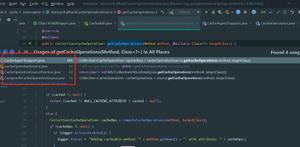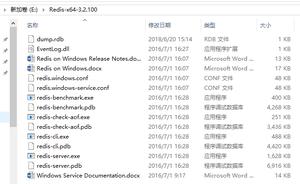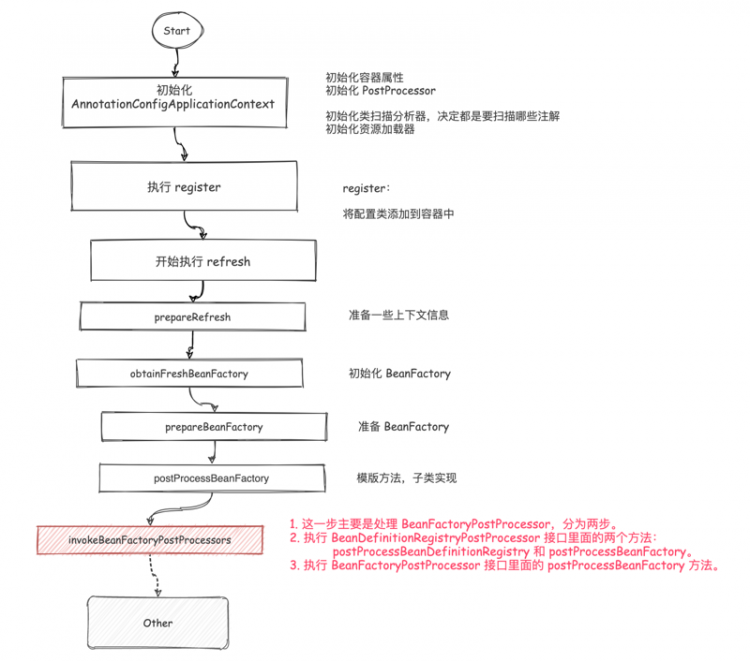Spring动态代理及Spring Bean的生命周期
本文内容纲要:
- 数组添加值- 数组(arrays)
- 静态代理
- 5.使用多种方式实现AOP
- 5.1 JDK动态代理
- 6.Spring Bean的生命周期
- 6.1生命周期流程图:
- 6.2各种接口方法分类
- 6.3演示
- 前置增强
- 环绕式增强
- 异常增强
数组添加值
public class DiTest { /**
* 数组
*/
private String [] arrays;
/**
* List:集合
*/
private List<Integer> lists;
/**
* Set: 无序集合
*/
private Set<String> sets;
/**
* Map
*/
private Map<String,Object> maps;
/**
* 配置
*/
private Properties properties;
首先先编写一个applicationContextList.xml大配置文件
然后在到大配置里面配置实体类名
<bean id="diTest" class="com.wdkseft.entity.DiTest">数组(arrays)
<!--数组--><property name="arrays">
<array>
<value>呵呵</value>
<value>啦啦</value>
</array>
</property>
List
<!--list--><property name="lists">
<list>
<value>18</value>
<value>19</value>
</list>
</property>
Set
<!--set--><property name="sets">
<set>
<value>ashdads</value>
<value>ajfiasdj</value>
</set>
</property>
Map
<!--Map--><property name="maps">
<map>
<entry key="name" value="lll"></entry>
<entry key="age" value="18"></entry>
</map>
</property>
properties
<!--properties--><property name="properties">
<props>
<prop key="jdbc.drver">com.mysql.jdbc.Driver</prop>
<prop key="jdbc.username">root</prop>
</props>
</property>
单步执行
@Testpublic void List(){
ApplicationContext ctx = new ClassPathXmlApplicationContext("applicationContextList.xml");
DiTest diTest = (DiTest) ctx.getBean("diTest");
System.out.println(diTest.toString());
}
静态代理
首先先声明一个主题
/** * 抽象主题:真实业务接口
*/
public interface Subject {
void doSome();
}
然后声明一个真实的主题 生成真实主题的方法
//真实主题private Subject subject=new RealSubject();
public class ProxySubject implements Subject {
//真实主题
private Subject subject=new RealSubject();
@Override
public void doSome() {
//aop思想:增强
System.out.println("前置增强==========");
subject.doSome();
System.out.println("后置增强==========");
}
}
5.使用多种方式实现AOP
Spring AOP实现原理:动态代理
5.1 JDK动态代理
JDK动态代理所用到的代理类在程序调用到代理类对象时才由JVM真正创建,JVM根据传进来的 业务实现类对象 以及 方法名 ,动态地创建了一个代理类的class文件并被字节码引擎执行,然后通过该代理类对象进行方法调用。
/** * 真实主题:将雨业务代码封装到这里
*/
public class RealSubject implements Subject {
@Override
public void doSome() {
System.out.println("==============真实业务=============");
}
}
2. 调用接口
public class ProxySubject implements Subject { //真实主题
private Subject subject=new RealSubject();
@Override
public void doSome() {
//aop思想:增强
System.out.println("前置增强==========");
subject.doSome();
System.out.println("后置增强==========");
}
}
单步执行
@Testpublic void Spring(){
ProxySubject proxySubject = new ProxySubject();
proxySubject.doSome();
}
5.2 CGLIB动态代理
CGLIB是针对类来实现代理的,原理是对指定的业务类生成一个子类,并覆盖其中业务方法实现代理。因为采用的是继承,所以不能对final修饰的类进行代理。在JDK动态代理的基础之上新建新的代理工厂Bean
/** * 业务类
*/
public class IService {
public void doSome(){
System.out.println("我是实现业务的方法");
}
}
编写测试类
public static void main(String[] args) { //CGLIB动态代理(当前项目必须有CGLIB的支持)
//步骤一:目标对象
final IService iService=new IService();
//步骤二:通过CGLIB提供的Enhancer类生成代理
Enhancer enhancer=new Enhancer();
//步骤三:指定需要代理的目标对象模板(将目标对象放入到代理工厂当中,生成代理对象)
enhancer.setSuperclass(iService.getClass());
//步骤四:实现增强的处理操作
enhancer.setCallback(new MethodInterceptor() {
/**
*
* @param o 目标对象
* @param method 目标对象的方法
* @param objects 目标对象方法内的参数
* @param methodProxy 代理目标对象方法
* @return
* @throws Throwable
*/
@Override
public Object intercept(Object o, Method method, Object[] objects, MethodProxy methodProxy) throws Throwable {
System.out.println("前置");
Object invoke = methodProxy.invoke(iService, objects);
System.out.println("后置");
return invoke;
}
});
//最后一步:创建代理
IService iServiceProxy = (IService)enhancer.create();
iServiceProxy.doSome();
6.Spring Bean的生命周期
6.1生命周期流程图:
Spring Bean的完整生命周期从创建Spring容器开始,直到最终Spring容器销毁Bean,这其中包含了一系列关键点。
若容器注册了以上各种接口,程序那么将会按照以上的流程进行。下面将仔细讲解各接口作用。
6.2****各种接口方法分类
Bean的完整生命周期经历了各种方法调用,这些方法可以划分为以下几类:
1、Bean自身的方法:这个包括了Bean本身调用的方法和通过配置文件中
2、Bean级生命周期接口方法:这个包括了BeanNameAware、BeanFactoryAware、InitializingBean和DiposableBean这些接口的方法
3、容器级生命周期接口方法:这个包括了InstantiationAwareBeanPostProcessor 和 BeanPostProcessor 这两个接口实现,一般称它们的实现类为“后处理器”。
4、工厂后处理器接口方法:这个包括了AspectJWeavingEnabler, ConfigurationClassPostProcessor, CustomAutowireConfigurer等等非常有用的工厂后处理器 接口的方法。工厂后处理器也是容器级的。在应用上下文装配配置文件之后立即调用。
6.3演示
1、首先是一个简单的Spring Bean,调用Bean自身的方法和****Bean级生命周期接口方法,为了方便演示,它实现了BeanNameAware、BeanFactoryAware、InitializingBean和DiposableBean这4个接口,同时有2个方法,对应配置文件中的init-method和destroy-method。如下:
/** * @author qsk
*/
public class Person implements BeanFactoryAware, BeanNameAware,
InitializingBean, DisposableBean {
private String name;
private String address;
private int phone;
private BeanFactory beanFactory;
private String beanName;
public Person() {
System.out.println("【构造器】调用Person的构造器实例化");
}
public String getName() {
return name;
}
public void setName(String name) {
System.out.println("【注入属性】注入属性name");
this.name = name;
}
public String getAddress() {
return address;
}
public void setAddress(String address) {
System.out.println("【注入属性】注入属性address");
this.address = address;
}
public int getPhone() {
return phone;
}
public void setPhone(int phone) {
System.out.println("【注入属性】注入属性phone");
this.phone = phone;
}
@Override
public String toString() {
return "Person [address=" + address + ", name=" + name + ", phone="+ phone + "]";
}
// 这是BeanFactoryAware接口方法
@Override
public void setBeanFactory(BeanFactory arg0) throws BeansException {
System.out.println("【BeanFactoryAware接口】调用BeanFactoryAware.setBeanFactory()");
this.beanFactory = arg0;
}
// 这是BeanNameAware接口方法
@Override
public void setBeanName(String arg0) {
System.out.println("【BeanNameAware接口】调用BeanNameAware.setBeanName()");
this.beanName = arg0;
}
// 这是InitializingBean接口方法
@Override
public void afterPropertiesSet() throws Exception {
System.out
.println("【InitializingBean接口】调用InitializingBean.afterPropertiesSet()");
}
// 这是DiposibleBean接口方法
@Override
public void destroy() throws Exception {
System.out.println("【DiposibleBean接口】调用DiposibleBean.destory()");
}
// 通过<bean>的init-method属性指定的初始化方法
public void myInit() {
System.out.println("【init-method】调用<bean>的init-method属性指定的初始化方法");
}
// 通过<bean>的destroy-method属性指定的初始化方法
public void myDestory() {
System.out.println("【destroy-method】调用<bean>的destroy-method属性指定的初始化方法");
}
}
2、接下来是演示BeanPostProcessor接口的方法,如下:
package springBeanTest;import org.springframework.beans.BeansException;
import org.springframework.beans.factory.config.BeanPostProcessor;
public class MyBeanPostProcessor implements BeanPostProcessor {
public MyBeanPostProcessor() {
super();
System.out.println("这是BeanPostProcessor实现类构造器!!");
// TODO Auto-generated constructor stub
}
@Override
public Object postProcessAfterInitialization(Object arg0, String arg1)
throws BeansException {
System.out
.println("BeanPostProcessor接口方法postProcessAfterInitialization对属性进行更改!");
return arg0;
}
@Override
public Object postProcessBeforeInitialization(Object arg0, String arg1)
throws BeansException {
System.out
.println("BeanPostProcessor接口方法postProcessBeforeInitialization对属性进行更改!");
return arg0;
}
}
如上,BeanPostProcessor接口包括2个方法postProcessAfterInitialization和postProcessBeforeInitialization,这两个方法的第一个参数都是要处理的Bean对象,第二个参数都是Bean的name。返回值也都是要处理的Bean对象。这里要注意
3、InstantiationAwareBeanPostProcessor 接口本质是BeanPostProcessor的子接口,一般我们继承Spring为其提供的适配器类InstantiationAwareBeanPostProcessor Adapter来使用它,如下:
package springBeanTest;import java.beans.PropertyDescriptor;
import org.springframework.beans.BeansException;
import org.springframework.beans.PropertyValues;
import org.springframework.beans.factory.config.InstantiationAwareBeanPostProcessorAdapter;
public class MyInstantiationAwareBeanPostProcessor extends
InstantiationAwareBeanPostProcessorAdapter {
public MyInstantiationAwareBeanPostProcessor() {
super();
System.out
.println("这是InstantiationAwareBeanPostProcessorAdapter实现类构造器!!");
}
// 接口方法、实例化Bean之前调用
@Override
public Object postProcessBeforeInstantiation(Class beanClass,
String beanName) throws BeansException {
System.out
.println("InstantiationAwareBeanPostProcessor调用postProcessBeforeInstantiation方法");
return null;
}
// 接口方法、实例化Bean之后调用
@Override
public Object postProcessAfterInitialization(Object bean, String beanName)
throws BeansException {
System.out
.println("InstantiationAwareBeanPostProcessor调用postProcessAfterInitialization方法");
return bean;
}
// 接口方法、设置某个属性时调用
@Override
public PropertyValues postProcessPropertyValues(PropertyValues pvs,
PropertyDescriptor[] pds, Object bean, String beanName)
throws BeansException {
System.out
.println("InstantiationAwareBeanPostProcessor调用postProcessPropertyValues方法");
return pvs;
}
}
这个有3个方法,其中第二个方法postProcessAfterInitialization就是重写了BeanPostProcessor的方法。第三个方法postProcessPropertyValues用来操作属性,返回值也应该是PropertyValues对象。
package springBeanTest;import org.springframework.beans.BeansException;
import org.springframework.beans.factory.config.BeanDefinition;
import org.springframework.beans.factory.config.BeanFactoryPostProcessor;
import org.springframework.beans.factory.config.ConfigurableListableBeanFactory;
public class MyBeanFactoryPostProcessor implements BeanFactoryPostProcessor {
public MyBeanFactoryPostProcessor() {
super();
System.out.println("这是BeanFactoryPostProcessor实现类构造器!!");
}
@Override
public void postProcessBeanFactory(ConfigurableListableBeanFactory arg0)
throws BeansException {
System.out
.println("BeanFactoryPostProcessor调用postProcessBeanFactory方法");
BeanDefinition bd = arg0.getBeanDefinition("person");
bd.getPropertyValues().addPropertyValue("phone", "110");
}
}
5、配置文件如下beans.xml,很简单,使用ApplicationContext,处理器不用手动注册:
<?xml version="1.0" encoding="UTF-8"?><beans xmlns="http://www.springframework.org/schema/beans"
xmlns:xsi="http://www.w3.org/2001/XMLSchema-instance" xmlns:p="http://www.springframework.org/schema/p"
xmlns:aop="http://www.springframework.org/schema/aop" xmlns:tx="http://www.springframework.org/schema/tx"
xsi:schemaLocation="
http://www.springframework.org/schema/beans
http://www.springframework.org/schema/beans/spring-beans-3.2.xsd">
<bean id="beanPostProcessor" class="springBeanTest.MyBeanPostProcessor">
</bean>
<bean id="instantiationAwareBeanPostProcessor" class="springBeanTest.MyInstantiationAwareBeanPostProcessor">
</bean>
<bean id="beanFactoryPostProcessor" class="springBeanTest.MyBeanFactoryPostProcessor">
</bean>
<bean id="person" class="springBeanTest.Person" init-method="myInit"
destroy-method="myDestory" scope="singleton" p:name="张三" p:address="广州"
p:phone="15900000000" />
</beans>
6、下面测试一下:
package springBeanTest;import org.springframework.context.ApplicationContext;
import org.springframework.context.support.ClassPathXmlApplicationContext;
public class BeanLifeCycle {
public static void main(String[] args) {
System.out.println("现在开始初始化容器");
ApplicationContext factory = new ClassPathXmlApplicationContext("springBeanTest/beans.xml");
System.out.println("容器初始化成功");
//得到Preson,并使用
Person person = factory.getBean("person",Person.class);
System.out.println(person);
System.out.println("现在开始关闭容器!");
((ClassPathXmlApplicationContext)factory).registerShutdownHook();
}
}
关闭容器使用的是实际是AbstractApplicationContext的钩子方法。
我们来看一下结果:
现在开始初始化容器2014-5-18 15:46:20 org.springframework.context.support.AbstractApplicationContext prepareRefresh
信息: Refreshing org.springframework.context.support.ClassPathXmlApplicationContext@19a0c7c: startup date [Sun May 18 15:46:20 CST 2014]; root of context hierarchy
2014-5-18 15:46:20 org.springframework.beans.factory.xml.XmlBeanDefinitionReader loadBeanDefinitions
信息: Loading XML bean definitions from class path resource [springBeanTest/beans.xml]
这是BeanFactoryPostProcessor实现类构造器!!
BeanFactoryPostProcessor调用postProcessBeanFactory方法
这是BeanPostProcessor实现类构造器!!
这是InstantiationAwareBeanPostProcessorAdapter实现类构造器!!
2014-5-18 15:46:20 org.springframework.beans.factory.support.DefaultListableBeanFactory preInstantiateSingletons
信息: Pre-instantiating singletons in org.springframework.beans.factory.support.DefaultListableBeanFactory@9934d4: defining beans [beanPostProcessor,instantiationAwareBeanPostProcessor,beanFactoryPostProcessor,person]; root of factory hierarchy
InstantiationAwareBeanPostProcessor调用postProcessBeforeInstantiation方法
【构造器】调用Person的构造器实例化
InstantiationAwareBeanPostProcessor调用postProcessPropertyValues方法
【注入属性】注入属性address
【注入属性】注入属性name
【注入属性】注入属性phone
【BeanNameAware接口】调用BeanNameAware.setBeanName()
【BeanFactoryAware接口】调用BeanFactoryAware.setBeanFactory()
BeanPostProcessor接口方法postProcessBeforeInitialization对属性进行更改!
【InitializingBean接口】调用InitializingBean.afterPropertiesSet()
【init-method】调用<bean>的init-method属性指定的初始化方法
BeanPostProcessor接口方法postProcessAfterInitialization对属性进行更改!
InstantiationAwareBeanPostProcessor调用postProcessAfterInitialization方法
容器初始化成功
Person [address=广州, name=张三, phone=110]
现在开始关闭容器!
【DiposibleBean接口】调用DiposibleBean.destory()
@Test
public void Spring(){
ProxySubject proxySubject = new ProxySubject();
proxySubject.doSome();
}
后几种动态代理
** 前置增强**
首先需要主题对象
public interface IdomSomeService { void doSome();
}
/**
* 原始对象
*/
public class IdoSomeServiceImpl implements IdomSomeService {
@Override
public void doSome() {
System.out.println("=========真实事物=========");
}
}
工厂代理类(实现了MethodBeforeAdvice):
public class MyBeforeAdvice implements MethodBeforeAdvice { @Override
public void before(Method method, Object[] objects, Object o) throws Throwable {
System.out.println("=============前置增强=============");
}
}
创建applicationContext.xml大配置文件进行增强操作
<?xml version="1.0" encoding="UTF-8"?><beans xmlns="http://www.springframework.org/schema/beans"
xmlns:xsi="http://www.w3.org/2001/XMLSchema-instance"
xmlns:aop="http://www.springframework.org/schema/aop"
xsi:schemaLocation="http://www.springframework.org/schema/beans
http://www.springframework.org/schema/beans/spring-beans.xsd
http://www.springframework.org/schema/aop
http://www.springframework.org/schema/aop/spring-aop.xsd">
<!--注入业务Bean-->
<bean id="idomSomeService" class="cn.cglib.IdoSomeServiceImpl"></bean>
<!--增强:切面-->
<bean id="myBeforeAdvice" class="cn.cglib.MyBeforeAdvice"></bean>
<!--使用代理工厂实现增强 -->
<bean id="proxyFactory" class="org.springframework.aop.framework.ProxyFactoryBean">
<!--ProxyFactoryBean 将增强和业务织到一起-->
<property name="target" ref="idomSomeService"></property>
<!--拦截增强类-->
<property name="interceptorNames" value="myBeforeAdvice"></property>
<!--更换代理方式
proxyTargetClass默认值为false默认 是jdk动态代理,
但是当目标对象没有接口时,自动改为cglib-->
<property name="proxyTargetClass" value="true"></property>
</bean>
</beans>
实现类
public void cglib(){ ApplicationContext ctx = new ClassPathXmlApplicationContext("applicationContext.xml");
IdoSomeServiceImpl idoSomeService = (IdoSomeServiceImpl)ctx.getBean("proxyFactory");
idoSomeService.doSome();
}
环绕式增强
public interface IdomSomeService { void doSome();
}
/**
* 原始对象
*/
public class IdoSomeServiceImpl implements IdomSomeService {
@Override
public void doSome() {
System.out.println("=========真实事物=========");
}
}
创建工厂类 实现了MethodInterceptor接口
public class MyBeforeAdvice implements MethodInterceptor { @Override
public Object invoke(MethodInvocation invocation) throws Throwable {
System.out.println("========环绕前========");
//调用核心业务方法 也可以获取方法内的参数 也可以获取目标对象
Object proceed = invocation.proceed();
Object aThis = invocation.getThis();
System.out.println(aThis);
System.out.println("========环绕后========");
return proceed;
}
}
创建applicationContextHuan.xml大配置文件进行增强操作:
<?xml version="1.0" encoding="UTF-8"?><beans xmlns="http://www.springframework.org/schema/beans"
xmlns:xsi="http://www.w3.org/2001/XMLSchema-instance"
xmlns:aop="http://www.springframework.org/schema/aop"
xsi:schemaLocation="http://www.springframework.org/schema/beans
http://www.springframework.org/schema/beans/spring-beans.xsd
http://www.springframework.org/schema/aop
http://www.springframework.org/schema/aop/spring-aop.xsd">
<!--注入业务Bean-->
<bean id="idomSomeService" class="cn.cglib_huan.IdoSomeServiceImpl"></bean>
<!--增强:切面-->
<bean id="myBeforeAdvice" class="cn.cglib_huan.MyBeforeAdvice"></bean>
<!--使用代理工厂实现增强 -->
<bean id="proxyFactory" class="org.springframework.aop.framework.ProxyFactoryBean">
<!--ProxyFactoryBean 将增强和业务织到一起-->
<property name="target" ref="idomSomeService"></property>
<!--拦截增强类-->
<property name="interceptorNames" value="myBeforeAdvice"></property>
<!--更换代理方式
proxyTargetClass默认值为false默认 是jdk动态代理,
但是当目标对象没有接口时,自动改为cglib-->
<property name="proxyTargetClass" value="true"></property>
</bean>
</beans>
实现类与实现结果
@Testpublic void cglibHuan(){
ApplicationContext ctx = new ClassPathXmlApplicationContext("applicationContextHuan.xml");
IdoSomeServiceImpl idoSomeService = (IdoSomeServiceImpl)ctx.getBean("proxyFactory");
idoSomeService.doSome();
}
异常增强
public interface IdomSomeService { void doSome() throws Exception;
}
/**
* 原始对象
*/
public class IdoSomeServiceImpl implements IdomSomeService {
@Override
public void doSome() throws Exception {
int i =5/0;
System.out.println("=========真实事物=========");
}
}
创建工厂类 实现ThrowsAdvice接口
public class MyBeforeAdvice implements ThrowsAdvice { public void afterThrowing(Exception ex){
System.out.println("发生异常");
}
}
创建applicationContextExection.xml大配置文件进行增强操作:
<?xml version="1.0" encoding="UTF-8"?><beans xmlns="http://www.springframework.org/schema/beans"
xmlns:xsi="http://www.w3.org/2001/XMLSchema-instance"
xmlns:aop="http://www.springframework.org/schema/aop"
xsi:schemaLocation="http://www.springframework.org/schema/beans
http://www.springframework.org/schema/beans/spring-beans.xsd
http://www.springframework.org/schema/aop
http://www.springframework.org/schema/aop/spring-aop.xsd">
<!--注入业务Bean-->
<bean id="idomSomeService" class="cn.cglib_exception.IdoSomeServiceImpl"></bean>
<!--增强:切面-->
<bean id="myBeforeAdvice" class="cn.cglib_exception.MyBeforeAdvice"></bean>
<!--使用代理工厂实现增强 -->
<bean id="proxyFactory" class="org.springframework.aop.framework.ProxyFactoryBean">
<!--ProxyFactoryBean 将增强和业务织到一起-->
<property name="target" ref="idomSomeService"></property>
<!--拦截增强类-->
<property name="interceptorNames" value="myBeforeAdvice"></property>
<!--更换代理方式
proxyTargetClass默认值为false默认 是jdk动态代理,
但是当目标对象没有接口时,自动改为cglib-->
<property name="proxyTargetClass" value="true"></property>
</bean>
</beans>
相当于把异常抛出去,让代码继续执行
执行类
@Test public void Text() {
ApplicationContext ctx = new ClassPathXmlApplicationContext("applicationContextEx.xml");
IdoSomeServiceImpl proxyFactory = (IdoSomeServiceImpl)ctx.getBean("proxyFactory");
try {
proxyFactory.doSome();
} catch (Exception e) {
e.printStackTrace();
}
System.out.println("23456123456");
}
本文内容总结:数组添加值,数组(arrays),静态代理,5.使用多种方式实现AOP,5.1 JDK动态代理,6.Spring Bean的生命周期,6.1生命周期流程图:,6.2各种接口方法分类,6.3演示, 前置增强,环绕式增强,异常增强,
原文链接:https://www.cnblogs.com/ws1149939228/p/11752705.html
以上是 Spring动态代理及Spring Bean的生命周期 的全部内容, 来源链接: utcz.com/z/362464.html








